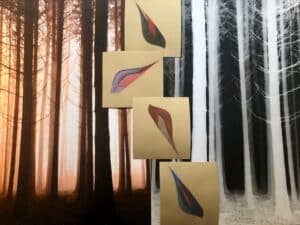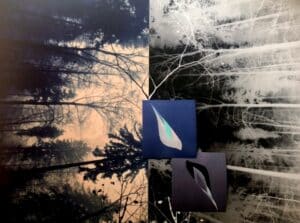

Exhibited in Zurich (Switzerland) from April 20 – May 7, 2023 at the gallery Photobastei
Like color harmonies, color stories are hard to define or delimit. Color is metamorphosis, flux, eternal becoming, panta rhei. The elusive nature of color holds many levels of possible “truths” and contradictory semantics. In the natural world, an arresting color may bear conflicting meanings: a danger warning or a sign of seduction – sometimes both. Modern science based on measurement, predictability, and quantifiability has largely dismissed the information obtained through color as a secondary quality of the physical world and relegated it to the domain of subjective perception. Yet the conundrum of taming color into taxonomies has perpetually intrigued the natural sciences. “Werner’s Nomenclature of Colours” (1814) ventured to classify the colors of the natural world with a language reminiscent of poetry: “Rose Red, is carmine red, with a great quantity of snow white, and a very small portion of cochineal red.” Even in the 21st century, when color nomenclatures have long resorted to more “objective” taxonomies by numbers, we continue to inscribe our aesthetic selves into the way we tell the stories of colors and give them names – like in the “End of Days Orange” coined on social media to describe the fire and smoke that engulfed San Francisco Bay at the height of the 2020 pandemic. We romanticize the mystery. We need the context of a story.
Color is perfect for mystery. H. P. Lovecraft was aware of this when he conceived of a clandestine source of a color, one of an alien entity. In his short story “The Colour Out of Space,” strange and gradual color changes of the natural world occur after an asteroid has hit the Earth. The apocalyptic in his story creeps in gently and is primarily noticeable through odd color shifts. The chromatic uncanny is located in uncertainty, in that moment of limbo between the possible, the known, and the unimaginable.
“Fantastic Color Nomenclature” lingers in the suspense of uncertainty – before a Kippmoment, a turning point, where aesthetic pleasure possibly veils tragic implications. A dark, seemingly lifeless photographed forest is furnished with drawings of birds that evoke the visual registers of scientific taxonomies. In the darkened palette of the forest, the harmonious arrangement of colors holds the promise of seduction as well as doom. By joining the pictorial and photographic traditions, the work stages a fantastic scenario against the background of the forest on Zurich’s Käferberg hill. And sure enough, as this text is finished, the forest areas on the Käferberg no longer exist. A thunderstorm in summer 2021 obliterated the trees. Both the drawings and the photographs now refer only to imaginary pictures. In the “Age of Extinction” proclaimed by the contemporary media, however, these images may always point to a tomorrow. At the outset, as with Lovecraft’s asteroid, the causes of strange, beautiful, alarming, or fascinating colors are usually clad in an air of mystery. And sometimes the resolution of the mystery points back to our ecological, cognitive, or simply aesthetic selves.